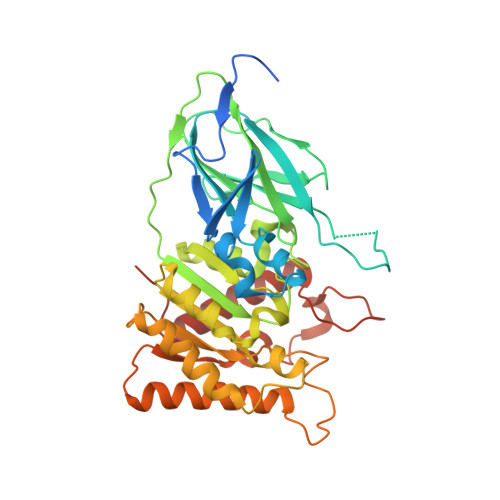Structural and Biochemical Characterization of the Salicylyl-acyltranferase SsfX3 from a Tetracycline Biosynthetic Pathway.
Pickens, L.B., Sawaya, M.R., Rasool, H., Pashkov, I., Yeates, T.O., Tang, Y.(2011) J Biol Chem 286: 41539-41551
- PubMed: 21965680
- DOI: https://doi.org/10.1074/jbc.M111.299859
- Primary Citation of Related Structures:
3SKV - PubMed Abstract:
SsfX3 is a GDSL family acyltransferase that transfers salicylate to the C-4 hydroxyl of a tetracycline intermediate in the penultimate step during biosynthesis of the anticancer natural product SF2575. The C-4 salicylate takes the place of the more common C-4 dimethylamine functionality, making SsfX3 the first acyltransferase identified to act on a tetracycline substrate. The crystal structure of SsfX3 was determined at 2.5 Å, revealing two distinct domains as follows: an N-terminal β-sandwich domain that resembles a carbohydrate-binding module, and a C-terminal catalytic domain that contains the atypical α/β-hydrolase fold found in the GDSL hydrolase family of enzymes. The active site lies at one end of a large open binding pocket, which is spatially defined by structural elements from both the N- and C-terminal domains. Mutational analysis in the putative substrate binding pocket identified residues from both domains that are important for binding the acyl donor and acceptor. Furthermore, removal of the N-terminal carbohydrate-binding module-like domain rendered the stand-alone α/β-hydrolase domain inactive. The additional noncatalytic module is therefore proposed to be required to define the binding pocket and provide sufficient interactions with the spatially extended tetracyclic substrate. SsfX3 was also demonstrated to accept a variety of non-native acyl groups. This relaxed substrate specificity toward the acyl donor allowed the chemoenzymatic biosynthesis of C-4-modified analogs of the immediate precursor to the bioactive SF2575; these were used to assay the structure activity relationships at the C-4 position.
Organizational Affiliation:
Departments of Chemical and Biomolecular Engineering, Los Angeles, California 90095.















